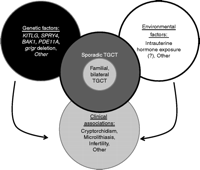Familial testicular germ cell tumors in adults: 2010 summary of genetic risk factors and clinical phenotype
- Mark H Greene,
- Christian P Kratz,
- Phuong L Mai,
- Christine Mueller,
- June A Peters,
- Gennady Bratslavsky1,
- Alex Ling2,
- Peter M Choyke3,
- Ahalya Premkumar2,
- Janet Bracci4,
- Rissah J Watkins4,
- Mary Lou McMaster5 and
- Larissa A Korde
- Clinical Genetics Branch, Division of Cancer Epidemiology and Genetics, National Cancer Institute, Bethesda, Maryland 20852, USA
1Urologic Oncology Branch, National Cancer Institute, Center for Cancer Research, Bethesda, Maryland 20852, USA
2Diagnostic Radiology Department, National Institutes of Health, Warren G. Magnuson Clinical Center, Bethesda, Maryland 20892, USA
3Molecular Imaging Program, National Cancer Institute, Bethesda, Maryland 20852, USA
4Westat, Inc., 6116 Executive Boulevard, Suite 400, Rockville, Maryland, USA
5Genetic Epidemiology Branch, Division of Cancer Epidemiology and Genetics, National Cancer Institute, Bethesda, Maryland 20852, USA
- (Correspondence should be addressed to M H Greene; Email: greenem{at}mail.nih.gov)
-
Figure 1
Factors contributing to the pathogenesis of testicular germ cell tumors. Several genes and genomic regions have been implicated in the pathogenesis of testicular germ cell tumors (TGCTs). Interestingly, all these loci have also been implicated in testicular development. While these variations explain a proportion of the genetic risk, the remaining genetic factors remain undetermined. Epidemiologic data strongly suggest that TGCTs have a significant environmental component. However, these external factors remain poorly defined. Some of the same factors that lead to TGCTs also underlie infertility, providing an explanation for the clinical association between TGCTs and infertility. Possibly, similar relationships are also true for microlithiasis and cryptorchidism. It is conceivable that the familial form of TGCTs is caused by the same factors that lead to sporadic TGCTs; however, we hypothesize that patients with the familial and/or bilateral form of TGCTs have a higher risk score (e.g. a larger number of risk factors).
- © 2010 Society for Endocrinology













